Energy Demand of the Road Transport Sector of Saudi Arabia—Application of a Causality-Based Machine Learning Model to Ensure Sustainable Environment
Abstract
1. Introduction
- This research employs a vector error correction model (VECM) for causality test analysis to identify a short and long-term relationship between the dependent and explanatory variables;
- This paper develops an SVR model for forecasting energy consumption in the Kingdom’s road transportation between 2018 and 2030 using a double exponential smoothing method using the projected input dataset.
- Finally, it compares the results from the SVR model with an ANN model to identify a suitable model for Saudi Arabia’s energy demand in the transportation sector. The ANN model is chosen for comparison purposes due to its popularity in transportation sector energy demand modeling.
2. Methodology
2.1. Model Data
2.2. Causality Analysis Approach
2.2.1. Unit Root Test
2.2.2. Co-Integration Test
2.2.3. Granger Causality Test
2.3. Prediction Approach
- Step
- 1: Input Processing—All the input data exhibit an increasing trend. Each variable’s linear trend is removed by developing a first-order linear regression model with the year as an input. A set of modified variables is obtained by eliminating the linear trend. In the next stage, normalization is performed to scale the data within the range between −1 and 1;
- Step
- 2: Input Projection—A double exponential smoothing technique is employed to project the input data between 2018 and 2030;
- Step
- 3: Model Development—The model is developed using the normalized input data between 1976 and 2004;
- Step
- 4: Model Testing—The model is tested for the training data between 1976 and 2004 and the testing data between 2004 and 2017, considering suitable error measures;
- Step
- 5: Output Forecasting—The model is utilized to make projections regarding the output. (road transport energy consumption in Saudi Arabia) for the period between 2018 and 2030 using the projected input data.
2.3.1. Double Exponential Smoothing
2.3.2. Support Vector Regression
2.3.3. Artificial Neural Networks
2.4. Model Development
3. Results and Discussion
3.1. Causality Analysis Model Results
3.2. AI-Based Model Results
4. Conclusions and Policy Implementation
Author Contributions
Funding
Institutional Review Board Statement
Informed Consent Statement
Data Availability Statement
Acknowledgments
Conflicts of Interest
Appendix A
| Country and Ref. | Methodology | Model Data | Forecasting Period | Predicted Variable | Predictor Variables |
|---|---|---|---|---|---|
| India by Bose et al. in 1997 [60] | LEAP (Long-range Energy Alternatives Planning) | 1981–1989 | 1990–2010 | Passenger transport energy consumption | Total number of vehicles, VMT (vehicles miles traveled), occupancy level, modal split, and fuel efficiency |
| Europe by Zachariadis et al. in 2003 [61] | Macro-economic forecast | 1970–1999 | 2000–2030 | Transport energy demand | GDP, population, VMT, occupancy rate, and fuel consumption |
| Nepal by Dhakal in 2003 [62] | LEAP | 1998–2000 | 2005–2020 | Passenger transport energy consumption | Total number of vehicles, annual vehicle kilometers traveled, occupancy level, and fuel efficiency |
| Turkey by Ozturk et al. in 2004 [19] | Genetic algorithm | 1975–2002 | 2002–2020 | Energy demand | Population, GDP, house production, export, and import |
| Turkey by Haldenbilen et al. in 2005 [22] | Linear and quadratic equations using harmonic search | 1990–2000 | 2002–2020 | Energy demand | Population, GDP, and VMT |
| Murat and Ceylan in 2006 [13] | ANN | 1970–2001 | 2002–2020 | Energy demand | GNP, population, annual average vehicle km, and historical energy data |
| Greece by Polemis in 2006 [63] | Log-linear model | 1978–2003 | Not specified | Diesel demand | Per capita income and vehicle fleet, and gasoline and diesel prices |
| South Korea by Geem et al. in 2007 [64] | ANN | 1980–2007 | Not specified | Energy demand | GDP, import, export, and population |
| Turkey by Edigar et al. in 2007 [65] | Autoregressive Integrated Moving Average (ARIMA) | 1950–2004 | 2005–2020 | Primary energy demand | GDP, population, import, and export |
| Turkey by Sozen et al. in 2007 [66] | ANN | 1968–2005 | Not specified | Net energy demand | GDP, population, import, and export |
| Turkey by Ceylan et al. in 2008 [67] | Linear and quadratic equations using harmonic search | 1970–2005 | 2006–2025 | Road transport energy demand | Population, GDP, and VMT |
| China by Yan et al. in 2009 [68] | LEAP | 2000–2005 | 2005–2030 | Road transport energy demand | Total number of vehicles, VMT, and fuel economy |
| Taiwan by Lu et al. in 2009 [69] | Grey forecasting model | 1990–2006 | 2007–2025 | Road transport energy demand | Population, GDP, and VMT |
| Pakistan by Shabbir et al. in 2010 [70] | LEAP | 2000 | 2000–2030 | Urban passenger transport energy consumption | Total number of vehicles, VMT, occupancy level, modal split, and fuel efficiency |
| Iran by Behrang et al. in 2011 [71] | Bee algorithm | 1981–2005 | 2006–2030 | Energy demand | population, GDP, export, and import |
| South Korea by Geem in 2011 [14] | ANN | 1990–2007 | 2008–2025 | Energy demand | GDP, population, passenger transport amount, number of vehicle registrations, and oil price |
| Jordan by AhmedAl-Ghandoor et al. in 2012 [72] | Adaptive neuro-fuzzy inference system (ANFIS) | 1985–2009 | 2010–2030 | Energy demand | vehicles no./year, vehicle ownership and income level, and fuel price |
| Croatia by Pukšec et al. in 2013 [73] | Energy demand of transport (EDT) model | Not specified | 2008–2050 | Long-term energy demand | Railway, road, seawater and coastal, inland waterway, and air transports |
| Iran by Sadri et al. in 2014 [74] | LEAP and EnergyPLAN | 1997–2008 | 2009–2025 | Long-term energy demand | GDP and population |
| United States by Kialashaki and Reisel in 2014 [75] | ANN and multiple linear regression | 1981–2009 | 2010–2030 | Energy demand | GDP, population, oil price, and vehicles |
| Thailand by Tansawat et al. in 2015 [76] | Linear and log-linear regression models | 2007 | Not specified | Transport fuel consumption | Gross provincial product, total number of sedans and gas stations, and a few dummy variables |
| Malaysia by Azam et al. in 2016 [77] | LEAP | 1990–2012 | 2013–2040 | Long-term energy demand | Historical data |
| China by Chai et al. in 2016 [78] | ARIMA and ETS (Error, Trend, Seasonal) models | 1971–2011 | 2012–2020 | Energy demand | GDP, employment, urbanization rate, core business tax, total road turnover, highway mileage, car manufacturing charges, and automobile industry output |
| Saudi Arabia by Alshehry and Belloumia in 2017 [79] | Environmental Kuznets curve | 1971–2011 | Not specified | Transport CO2 emissions | GDP, transport CO2 emissions, and transport energy consumption |
| China by Teng et al. in 2017 [80] | Group method of data handling | 1980–2011 | 2012–2052 | Long-term energy demand | GDP, population, urbanization rate, incomes, passenger, and freight turnovers, registered vehicle numbers, and fuel retail price index |
| 24 countries in the Latin America by Llorca et al. in 2017 [81] | Stochastic frontier approach | 1990–2010 | Not specified | Energy demand | GDP, population, energy price index, gross value added, and population density |
| China by Peng et al. in 2018 [82] | CPREG model | 2015 | 2015–2050 | Energy demand and GHG emissions | GDP, population, vehicle miles traveled, and vehicle stock |
| New Zealand by Hasan et al. in 2019 [10] | Regression | 1990–2016 | 2017–2030 | Emissions from the road transport sector | Demography and urban economics, energy, socio-economic development transport factors, and politics and policies |
| Indonesia by Deendarlianto et al. in 2020 [83] | Sustainable mobility project (SMP) model | 1999 –2013 | 2014–2030 | Energy demand | GDP, population, vehicle type, travel distance, and fuel economy |
| Turkey by Talebi et al. in 2021 [84] | ANN | 1975–2016 | 2020–2030 | Energy demand | GDP, population, oil prices, ton-km, vehicle-km, and passenger-km |
| Taiwan by Yao et al. in 2021 [85] | Convolutional neural network | 1999–2019 | Up to 2025 | Energy demand | GDP, population, number of registered vehicles, passenger transport value, and oil price |
| Turkey by Sahraei et al. in 2021 [86] | Multivariate adaptive regression splines | 1975–2019 | 2020–2030 | Energy demand | GDP, population, oil price, vehicle-km, passenger-km, and ton-km |
| Malaysia by Solaymani in 2022 [87] | Autoregressive distributed lag (ARDL) | 1978–2018 | Not specified | CO2 emissions | GDP, urbanization, energy and carbon intensity, and renewable energy in energy mix. |
| Turkey by Turgut et al. in 2021 [88] | OPTSGULL algorithm | 1970–2017 | 2018–2028 | Energy demand | GDP, population, employment, trade, inflation, crude oil price, total amount of goods transported, and total vehicle travel in km |
| Turkey by Özdemiïr and Dörterler in 2022 [89] | Linear, exponential, and quadratic models assisted by heuristic algorithm | 1970–2013 | 2014–2034 | Energy demand | GDP, total vehicle kilometer/year, population |
| Morocco Oubnaki et al. in 2022 [90] | Regression models | 1990–2014 | 2020–2030 | Energy demand | GDP, population, urbanization, fuel price, working women rate, number of vehicles registration and active vehicles on the road, and activity rate by gender and category |
| 28 European countries by Maaouane et al. in 2022 [91] | ANN | 1990–2019 | 2020–2050 | Energy demand | GDP, population, population density, gasoline and diesel price, purchasing power parity, price index, and household final consumption expenditure |
| Turkey by Sahraei and Çodur in 2022 [86] | Hybrid meta-heuristic ANN | 1975–2019 (First 80%) | 1975–2019 (Last 20%) | Energy demand | GDP, population, oil price, passenger-km, vehicle-km, and ton-km |
| Pakistan by Asim et al. in 2022 [92] | LEAP | 2003–2018 | 2019–2035 | Energy consumption | Historical energy consumption data |
References
- Shah, I.; Iftikhar, H.; Ali, S. Modeling and Forecasting Electricity Demand and Prices: A Comparison of Alternative Approaches. J. Math. 2022, 2022, 3581037. [Google Scholar] [CrossRef]
- Nan, R.; Xu, H. The Relationship between Energy Consumption and Economic Growth Based on Vector Error Correction Model. Chem. Eng. Trans. 2018, 67, 817–822. [Google Scholar]
- Rahman, M.M.; Hasan, M.A.; Shafiullah, M.; Rahman, M.S.; Arifuzzaman, M.; Islam, M.K.; Islam, M.M.; Rahman, S.M. A Critical, Temporal Analysis of Saudi Arabia’s Initiatives for Greenhouse Gas Emissions Reduction in the Energy Sector. Sustainability 2022, 14, 12651. [Google Scholar] [CrossRef]
- Fonseca, J.; Vieira, M.; Madeira, H. Training Security Assurance Teams Using Vulnerability Injection. In Proceedings of the 14th IEEE Pacific Rim International Symposium on Dependable Computing, Taipei, Taiwan, 15–17 December 2008; IEEE: Piscataway, NJ, USA, 2008; pp. 297–304. [Google Scholar]
- Porteiro, R.; Hernández-Callejo, L.; Nesmachnow, S. Electricity Demand Forecasting in Industrial and Residential Facilities Using Ensemble Machine Learning. Rev. Fac. Ing. 2022, 102, 9–25. [Google Scholar] [CrossRef]
- Rahman, S.M.; Al-Ismail, F.S.; Haque, M.E.; Shafiullah, M.; Islam, M.R.; Chowdhury, M.T.; Alam, M.S.; Razzak, S.A.; Ali, A.; Khan, Z.A. Electricity Generation in Saudi Arabia: Tracing Opportunities and Challenges to Reducing Greenhouse Gas Emissions. IEEE Access 2021, 9, 116163–116182. [Google Scholar] [CrossRef]
- Trewin, D. Year Book, Australia 2001. Available online: https://archive.org/stream/australianyearbook20011/Australian_Yearbook_2001-3_djvu.txt (accessed on 14 September 2022).
- World Atlas The 15 Richest Countries In The World—WorldAtlas. Available online: https://www.worldatlas.com/articles/the-richest-countries-in-the-world.html (accessed on 14 September 2022).
- Central Intelligence Agency of USA The World Factbook. Available online: https://www.cia.gov/the-world-factbook/about/cover-gallery/2017-cover/ (accessed on 14 September 2022).
- Hasan, M.A.; Frame, D.J.; Chapman, R.; Archie, K.M. Emissions from the Road Transport Sector of New Zealand: Key Drivers and Challenges. Environ. Sci. Pollut. Res. 2019, 26, 23937–23957. [Google Scholar] [CrossRef]
- Lee, C.; Chang, C. The Impact of Energy Consumption on Economic Growth: Evidence from Linear and Nonlinear Models in Taiwan. Energy 2007, 32, 2282–2294. [Google Scholar] [CrossRef]
- Haldenbilen, S.; Ceylan, H. Genetic Algorithm Approach to Estimate Transport Energy Demand in Turkey. Energy Policy 2005, 33, 89–98. [Google Scholar] [CrossRef]
- Murat, Y.S.; Ceylan, H. Use of Artificial Neural Networks for Transport Energy Demand Modeling. Energy Policy 2006, 34, 3165–3172. [Google Scholar] [CrossRef]
- Geem, Z.W. Transport Energy Demand Modeling of South Korea Using Artificial Neural Network. Energy Policy 2011, 39, 4644–4650. [Google Scholar] [CrossRef]
- Zhang, M.; Mu, H.; Li, G.; Ning, Y. Forecasting the Transport Energy Demand Based on PLSR Method in China. Energy 2009, 34, 1396–1400. [Google Scholar] [CrossRef]
- Kankal, M.; Akpınar, A.; Kömürcü, M.İ.; Özşahin, T.Ş. Modeling and Forecasting of Turkey’s Energy Consumption Using Socio-Economic and Demographic Variables. Appl. Energy 2011, 88, 1927–1939. [Google Scholar] [CrossRef]
- Limanond, T.; Jomnonkwao, S.; Srikaew, A. Projection of Future Transport Energy Demand of Thailand. Energy Policy 2011, 39, 2754–2763. [Google Scholar] [CrossRef]
- Soytas, U.; Sari, R. Energy Consumption and GDP: Causality Relationship in G-7 Countries and Emerging Markets. Energy Econ. 2003, 25, 33–37. [Google Scholar] [CrossRef]
- Ozturk, H.; Canyurt, O.; Hepbasli, A.; Utlu, Z. Residential-Commercial Energy Input Estimation Based on Genetic Algorithm (GA) Approaches: An Application of Turkey. Energy Build. 2004, 36, 175–183. [Google Scholar] [CrossRef]
- Canyurt, O.E.; Ceylan, H.; Ozturk, H.K.; Hepbasli, A. Energy Demand Estimation Based on Two-Different Genetic Algorithm Approaches. Energy Sources 2004, 26, 1313–1320. [Google Scholar] [CrossRef]
- Azadeh, A.; Ghaderi, S.; Sohrabkhani, S. Annual Electricity Consumption Forecasting by Neural Network in High Energy Consuming Industrial Sectors. Energy Convers. Manag. 2008, 49, 2272–2278. [Google Scholar] [CrossRef]
- An, N.; Zhao, W.; Wang, J.; Shang, D.; Zhao, E. Using Multi-Output Feedforward Neural Network with Empirical Mode Decomposition Based Signal Filtering for Electricity Demand Forecasting. Energy 2013, 49, 279–288. [Google Scholar] [CrossRef]
- Uzlu, E.; Kankal, M.; Akpınar, A.; Dede, T. Estimates of Energy Consumption in Turkey Using Neural Networks with the Teaching–Learning-Based Optimization Algorithm. Energy 2014, 75, 295–303. [Google Scholar] [CrossRef]
- Deshani, K.; Hansen, L.; Attygalle, M.D.T.; Karunarathne, A. Improved Neural Network Prediction Performances of Electricity Demand: Modifying Inputs through Clustering. In Proceedings of the Second International Conference on Computational Science and Engineering, Coimbatore, India, 26–28 October 2012; pp. 137–147. [Google Scholar]
- Li, Q.; Meng, Q.; Cai, J.; Yoshino, H.; Mochida, A. Applying Support Vector Machine to Predict Hourly Cooling Load in the Building. Appl. Energy 2009, 86, 2249–2256. [Google Scholar] [CrossRef]
- Jiang, Y.; Zhao, Q.; Lu, Y. Ensemble Based Data Stream Mining with Recalling and Forgetting Mechanisms. In Proceedings of the 11th International Conference on Fuzzy Systems and Knowledge Discovery (FSKD), Xiamen, China, 19–21 August 2014; IEEE: Piscataway, NJ, USA, 2014; pp. 430–435. [Google Scholar]
- Liao, S.; Chu, P.; Hsiao, P. Data Mining Techniques and Applications–A Decade Review from 2000 to 2011. Expert Syst. Appl. 2012, 39, 11303–11311. [Google Scholar] [CrossRef]
- Hong, W. Hybrid Evolutionary Algorithms in a SVR-Based Electric Load Forecasting Model. Electr. Power Energy Syst. 2009, 31, 409–417. [Google Scholar] [CrossRef]
- Shafiullah, M.; Abido, M.A.; Al-Mohammed, A.H. Power System Fault Diagnosis: A Wide Area Measurement Based Intelligent Approach, 1st ed.; Elsevier: Amsterdam, The Netherlands, 2022; ISBN 9780323884303. [Google Scholar]
- Jain, R.; Smith, K.M.; Culligan, P.J.; Taylor, J.E.; Jain, R.K.; Taylor, J.E. Forecasting Energy Consumption of Multi-Family Residential Buildings Using Support Vector Regression: Investigating the Impact of Temporal and Spatial Monitoring. Appl. Energy 2014, 123, 168–178. [Google Scholar] [CrossRef]
- Kavousi-Fard, A.; Samet, H.; Marzbani, F. A New Hybrid Modified Firefly Algorithm and Support Vector Regression Model for Accurate Short Term Load Forecasting. Expert Syst. Appl. 2014, 41, 6047–6056. [Google Scholar] [CrossRef]
- Omid, M.; Khoshnevisan, B.; Ramedani, Z.; Keyhani, A.; Shamshirband, S. Potential of Radial Basis Function Based Support Vector Regression for Global Solar Radiation Prediction. Energy Rev. 2014, 39, 1005–1011. [Google Scholar] [CrossRef]
- Chia, Y.; Lee, L.; Shafiabady, N.; Isa, D. A Load Predictive Energy Management System for Supercapacitor-Battery Hybrid Energy Storage System in Solar Application Using the Support Vector Machine. Appl. Energy 2015, 137, 588–602. [Google Scholar] [CrossRef]
- Fu, R. An Improved Support Vector Machine Algorithm and Its Application in Intelligent Transportation System. Chem. Eng. Trans. 2016, 51, 601–606. [Google Scholar]
- Jamal, A.; Reza, I.; Shafiullah, M. Modeling Retroreflectivity Degradation of Traffic Signs Using Artificial Neural Networks. IATSS Res. 2022, in press. [Google Scholar] [CrossRef]
- Meng, M.; Toan, T.D.; Wong, Y.D.; Lam, S.H. Short-Term Travel-Time Prediction Using Support Vector Machine and Nearest Neighbor Method. Transp. Res. Rec. J. Transp. Res. Board 2022, 2676, 353–365. [Google Scholar] [CrossRef]
- Ullah, I.; Liu, K.; Yamamoto, T.; Shafiullah, M.; Jamal, A. Grey Wolf Optimizer-Based Machine Learning Algorithm to Predict Electric Vehicle Charging Duration Time. Transp. Lett. 2022, 15, 1–18. [Google Scholar] [CrossRef]
- Zou, Y.; Hua, X.; Zhang, Y.; Wang, Y. Hybrid Short-Term Freeway Speed Prediction Methods Based on Periodic Analysis. Can. J. Civ. Eng. 2015, 42, 570–582. [Google Scholar] [CrossRef]
- Sun, J.; Sun, J.; Chen, P. Use of Support Vector Machine Models for Real-Time Prediction of Crash Risk on Urban Expressways. Transp. Res. Rec. J. Transp. Res. Board 2014, 2432, 91–98. [Google Scholar] [CrossRef]
- Rahman, M.M.; Rahman, S.M.; Rahman, M.S.; Hasan, A.; Shoaib, S.A.; Rushd, S. Greenhouse Gas Emissions from Solid Waste Management in Saudi Arabia—Analysis of Growth Dynamics and Mitigation Opportunities. Appl. Sci. 2021, 11, 1737. [Google Scholar] [CrossRef]
- The World Bank. World Development Indicators DataBank. Available online: https://databank.worldbank.org/source/world-development-indicators (accessed on 16 September 2022).
- Fedorova, D. Selection of Unit Root Test on the Basis of Length of the Time Series and Value of Ar (1) Parameter. Statistika 2016, 96, 3. [Google Scholar]
- Azlina, A.; Law, S.; Mustapha, N. Dynamic Linkages among Transport Energy Consumption, Income and CO2 Emission in Malaysia. Energy Policy 2014, 73, 598–606. [Google Scholar] [CrossRef]
- Johansen, S.; Juselius, K. Maximum Likelihood Estimation and Inference on Cointegration—With Appucations to the Demand for Money. Oxf. Bull. Econ. Stat. 1990, 52, 169–210. [Google Scholar] [CrossRef]
- Güzel, A.E.; Arslan, Ü. On the Nexus between Exchange Rate and Income Distribution in Turkey: ARDL Bound Testing Analysis. Econ. J. Emerg. Mark. 2019, 11, 1–7. [Google Scholar] [CrossRef]
- Sullivan, W.G.; Claycombe, W.W. Fundamentals of Forecasting, 1st ed.; Reston Pub. Co.: Reston, VA, USA, 1977; ISBN 978-0879093006. [Google Scholar]
- Lukman, M.; Tanan, B.; Khairina, D.M.; Daniel, Y.; Widagdo, P.P.; Sidqi, F.; Sumitra, I.D. Forecasting Product Selling Using Single Exponential Smoothing and Double Exponential Smoothing Methods. IOP Conf. Ser. Mater. Sci. Eng. 2019, 662, 032031. [Google Scholar] [CrossRef]
- Adamuthe, A.C.; Gage, R.A.; Thampi, G.T. Forecasting Cloud Computing Using Double Exponential Smoothing Methods. In Proceedings of the ICACCS 2015—2nd International Conference on Advanced Computing and Communication Systems, Coimbatore, India, 5–7 January 2015. [Google Scholar] [CrossRef]
- Cortes, C.; Vapnik, V.; Saitta, L. Support-Vector Networks. Mach. Learn. 1995, 20, 273–297. [Google Scholar] [CrossRef]
- Boser, B.E.; Guyon, I.M.; Vapnik, V.N. A Training Algorithm for Optimal Margin Classifiers. In Proceedings of the Fifth Annual ACM Workshop on Computational Learning Theory, Pittsburgh, PA, USA, 27–29 July 1992; ACM: New York, NY, USA, 1992; pp. 144–152. [Google Scholar]
- Vapnik, V. The Nature of Statistical Learning Theory; Springer: New York, NY, USA, 1995. [Google Scholar]
- Shafiullah, M.; Abido, M.A.; Al-Mohammed, A.H. Artificial Intelligence Techniques. In Power System Fault Diagnosis; Elsevier: Cambridge, MA, USA, 2022; Chapter 3; pp. 69–100. [Google Scholar] [CrossRef]
- Smola, A.J.; Schölkopf, B. A Tutorial on Support Vector Regression. Stat. Comput. 2004, 14, 199–222. [Google Scholar] [CrossRef]
- Burges, C.J.C. A Tutorial on Support Vector Machines for Pattern Recognition. Data Min. Knowl. Discov. 1998, 2, 121–167. [Google Scholar] [CrossRef]
- Usman, M.; Hussain, H.; Riaz, F.; Irshad, M.; Bashir, R.; Shah, M.H.; Zafar, A.A.; Bashir, U.; Kalam, M.A.; Mujtaba, M.A.; et al. Artificial Neural Network Led Optimization of Oxyhydrogen Hybridized Diesel Operated Engine. Sustainability 2021, 13, 9373. [Google Scholar] [CrossRef]
- Shahriar, M.S.; Shafiullah, M.; Rana, M.J.; Ali, A.; Ahmed, A.; Rahman, S.M. Neurogenetic Approach for Real-Time Damping of Low-Frequency Oscillations in Electric Networks. Comput. Electr. Eng. 2020, 83, 106600. [Google Scholar] [CrossRef]
- Shafiullah, M.; Abido, M.A.; Al-Mohammed, A.H. Intelligent Fault Diagnosis for Distribution Grid Considering Renewable Energy Intermittency. Neural Comput. Appl. 2022, 34, 16473–16492. [Google Scholar] [CrossRef]
- Ahmed, E.; Usman, M.; Anwar, S.; Ahmad, H.M.; Nasir, M.W.; Malik, M.A.I. Application of ANN to Predict Performance and Emissions of SI Engine Using Gasoline-Methanol Blends. Sci. Prog. 2021, 104, 00368504211002345. [Google Scholar] [CrossRef]
- Willmott, C.J. On the Validation of Models. Phys. Geogr. 1981, 2, 184–194. [Google Scholar] [CrossRef]
- Bose, R.; Srinivasachary, V. Policies to Reduce Energy Use and Environmental Emissions in the Transport Sector: A Case of Delhi City. Energy Policy 1997, 25, 1137–1150. [Google Scholar] [CrossRef]
- Zachariadis, T.; Kouvaritakis, N. Long-Term Outlook of Energy Use and CO2 Emissions from Transport in Central and Eastern Europe. Energy Policy 2003, 31, 759–773. [Google Scholar] [CrossRef]
- Dhakal, S. Implications of Transportation Policies on Energy and Environment in Kathmandu Valley, Nepal. Energy Policy 2003, 31, 1493–1507. [Google Scholar] [CrossRef]
- Polemis, M. Empirical Assessment of the Determinants of Road Energy Demand in Greece. Energy Econ. 2006, 28, 385–403. [Google Scholar] [CrossRef]
- Geem, Z.; Roper, W. Energy Demand Estimation of South Korea Using Artificial Neural Network. Energy Policy 2009, 37, 4049–4054. [Google Scholar] [CrossRef]
- Ediger, V.; Akar, S. ARIMA Forecasting of Primary Energy Demand by Fuel in Turkey. Energy Policy 2007, 35, 1701–1708. [Google Scholar] [CrossRef]
- Sözen, A.; Arcaklioglu, E. Prediction of Net Energy Consumption Based on Economic Indicators (GNP and GDP) in Turkey. Energy Policy 2007, 35, 4981–4992. [Google Scholar] [CrossRef]
- Ceylan, H.; Ceylan, H.; Haldenbilen, S.; Baskan, O. Transport Energy Modeling with Meta-Heuristic Harmony Search Algorithm, an Application to Turkey. Energy Policy 2008, 36, 2527–2535. [Google Scholar] [CrossRef]
- Yan, X.; Crookes, R. Reduction Potentials of Energy Demand and GHG Emissions in China’s Road Transport Sector. Energy Policy 2009, 37, 658–668. [Google Scholar] [CrossRef]
- Lu, I.; Lewis, C.; Lin, S. The Forecast of Motor Vehicle, Energy Demand and CO2 Emission from Taiwan’s Road Transportation Sector. Energy Policy 2009, 37, 2952–2961. [Google Scholar] [CrossRef]
- Shabbir, R.; Ahmad, S. Monitoring Urban Transport Air Pollution and Energy Demand in Rawalpindi and Islamabad Using Leap Model. Energy 2010, 35, 2323–2332. [Google Scholar] [CrossRef]
- Behrang, M.A.; Assareh, E.; Assari, M.R.; Ghanbarzadeh, A. Total Energy Demand Estimation in Iran Using Bees Algorithm. Energy Sources Part B Econ. Plan. Policy 2011, 6, 294–303. [Google Scholar] [CrossRef]
- Al-Ghandoor, A.; Samhouri, M.; Al-Hinti, I.; Jaber, J.; Al-Rawashdeh, M. Projection of Future Transport Energy Demand of Jordan Using Adaptive Neuro-Fuzzy Technique. Energy 2012, 38, 128–135. [Google Scholar] [CrossRef]
- Pukšec, T.; Krajačić, G.; Lulić, Z.; Mathiesen, B.V.; Duić, N. Forecasting Long-Term Energy Demand of Croatian Transport Sector. Energy 2013, 57, 169–176. [Google Scholar] [CrossRef]
- Sadri, A.; Ardehali, M.M.; Amirnekooei, K. General Procedure for Long-Term Energy-Environmental Planning for Transportation Sector of Developing Countries with Limited Data Based on LEAP (Long-Range Energy Alternative Planning) and EnergyPLAN. Energy 2014, 77, 831–843. [Google Scholar] [CrossRef]
- Kialashaki, A.; Reisel, J. Transport Energy Demand Modeling of the United States Using Artificial Neural Networks and Multiple Linear Regressions. In Proceedings of the ASME 2014 8th International Conference on Energy Sustainability collocated with the ASME 2014 12th International Conference on Fuel Cell Science, Engineering and Technology, Boston, MA, USA, 30 June–2 July 2014; Volume 2. [Google Scholar] [CrossRef]
- Tansawat, T.; Pochan, J.; Mofadal, A. Transport Energy Consumption Model for Thailand Provinces. In Proceedings of the 5th Atrans Symposium Student Chapter Session, Bangkok, Thailand, 24–25 August 2012; pp. 187–195. [Google Scholar]
- Azam, M.; Othman, J.; Begum, R.A.; Abdullah, S.M.S.; Nor, N.G.M. Energy Consumption and Emission Projection for the Road Transport Sector in Malaysia: An Application of the LEAP Model. Environ. Dev. Sustain. 2016, 18, 1027–1047. [Google Scholar] [CrossRef]
- Chai, J.; Lu, Q.Y.; Wang, S.Y.; Lai, K.K. Analysis of Road Transportation Energy Consumption Demand in China. Transp. Res. Part D Transp. Environ. 2016, 48, 112–124. [Google Scholar] [CrossRef]
- Alshehry, A.S.; Belloumi, M. Study of the Environmental Kuznets Curve for Transport Carbon Dioxide Emissions in Saudi Arabia. Renew. Sustain. Energy Rev. 2017, 75, 1339–1347. [Google Scholar] [CrossRef]
- Teng, G.; Xiao, J.; He, Y.; Zheng, T.; He, C. Use of Group Method of Data Handling for Transport Energy Demand Modeling. Energy Sci. Eng. 2017, 5, 302–317. [Google Scholar] [CrossRef]
- Llorca, M.; Baños, J.; Somoza, J.; Arbués, P. A Stochastic Frontier Analysis Approach for Estimating Energy Demand and Efficiency in the Transport Sector of Latin America and the Caribbean. Energy J. 2017, 38, 153–174. [Google Scholar] [CrossRef]
- Peng, T.; Ou, X.; Yuan, Z.; Yan, X.; Zhang, X. Development and Application of China Provincial Road Transport Energy Demand and GHG Emissions Analysis Model. Appl. Energy 2018, 222, 313–328. [Google Scholar] [CrossRef]
- Deendarlianto; Widyaparaga, A.; Widodo, T.; Handika, I.; Chandra Setiawan, I.; Lindasista, A. Modelling of Indonesian Road Transport Energy Sector in Order to Fulfill the National Energy and Oil Reduction Targets. Renew. Energy 2020, 146, 504–518. [Google Scholar] [CrossRef]
- Enerji, U.; Yapay, T.; Ağları, S.; Merve, M.; Çodur, K. Transportation Energy Demand Modeling with Artificial Neural Networks. J. Inst. Sci. Technol. 2021, 11, 2706–2715. [Google Scholar] [CrossRef]
- Yao, S.; Xu, Y.P.; Ramezani, E. Optimal Long-Term Prediction of Taiwan’s Transport Energy by Convolutional Neural Network and Wildebeest Herd Optimizer. Energy Rep. 2021, 7, 218–227. [Google Scholar] [CrossRef]
- Sahraei, M.A.; Çodur, M.K. Prediction of Transportation Energy Demand by Novel Hybrid Meta-Heuristic ANN. Energy 2022, 249, 123735. [Google Scholar] [CrossRef]
- Solaymani, S. CO2 Emissions and The Transport Sector in Malaysia. Front. Environ. Sci. 2022, 9, 714. [Google Scholar] [CrossRef]
- Turgut, M.S.; Eliiyi, U.; Turgut, O.E.; Öner, E.; Eliiyi, D.T. Artificial Intelligence Approaches to Estimate the Transport Energy Demand in Turkey. Arab. J. Sci. Eng. 2021, 46, 2443–2476. [Google Scholar] [CrossRef]
- Özdemïr, D.; Dörterler, S. An Adaptive Search Equation-Based Artificial Bee Colony Algorithm for Transportation Energy Demand Forecasting. Turk. J. Electr. Eng. Comput. Sci. 2022, 30, 1251–1268. [Google Scholar] [CrossRef]
- Oubnaki, H.; Haouraji, C.; Mounir, B.; Mounir, I.; Farchi, A. Energy Consumption in the Transport Sector: Trends and Forecast Estimates in Morocco. In Proceedings of the E3S Web of Conferences (ICEG’2021), Qingdao, China, 27–29 August 2021. [Google Scholar]
- Maaouane, M.; Chennaif, M.; Zouggar, S.; Krajačić, G.; Duić, N.; Zahboune, H.; Kerkour ElMiad, A. Using Neural Network Modelling for Estimation and Forecasting of Transport Sector Energy Demand in Developing Countries. Energy Convers. Manag. 2022, 258, 115556. [Google Scholar] [CrossRef]
- Asim, M.; Usman, M.; Abbasi, M.S.; Ahmad, S.; Mujtaba, M.A.; Soudagar, M.E.M.; Mohamed, A. Estimating the Long-Term Effects of National and International Sustainable Transport Policies on Energy Consumption and Emissions of Road Transport Sector of Pakistan. Sustainability 2022, 14, 5732. [Google Scholar] [CrossRef]

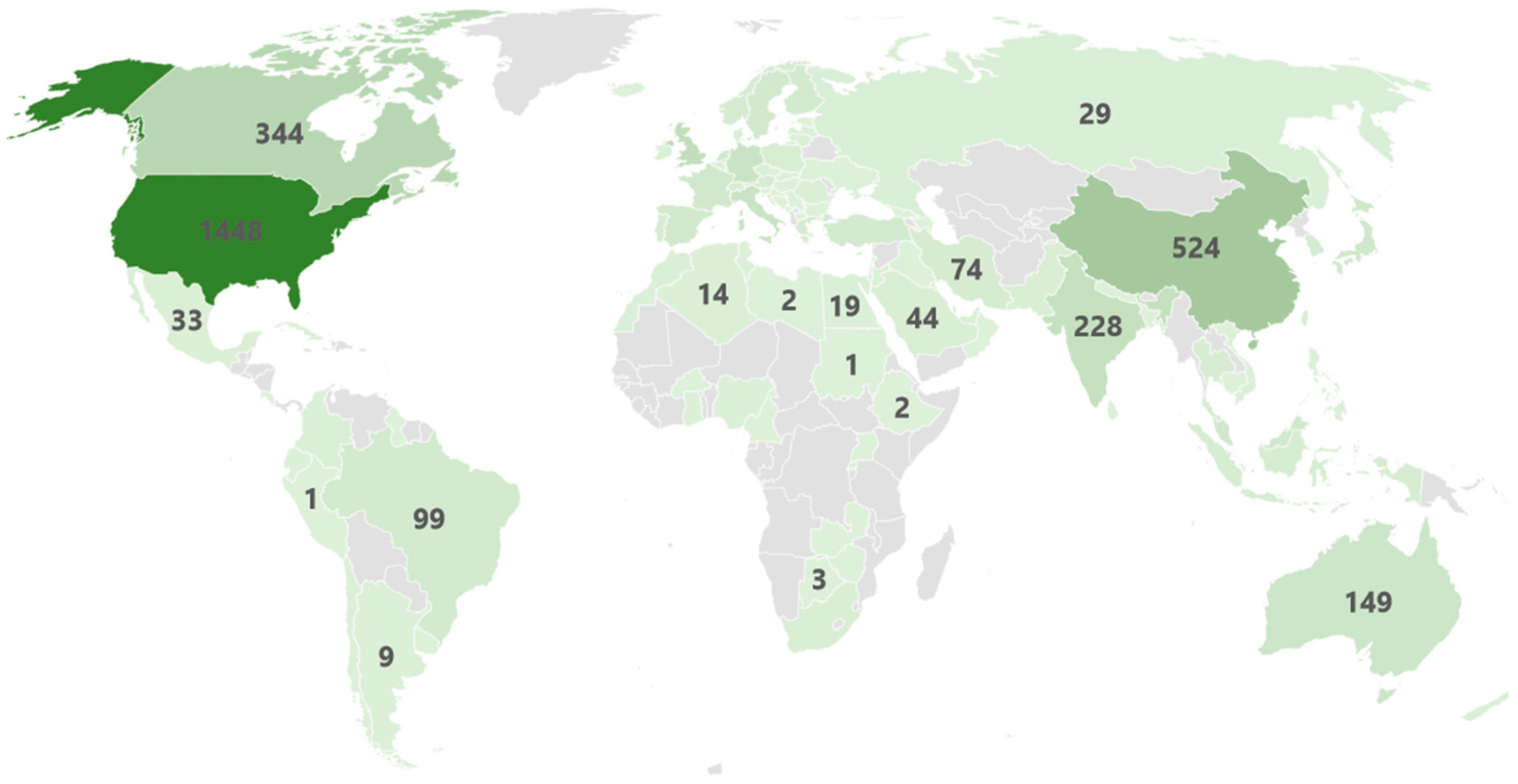

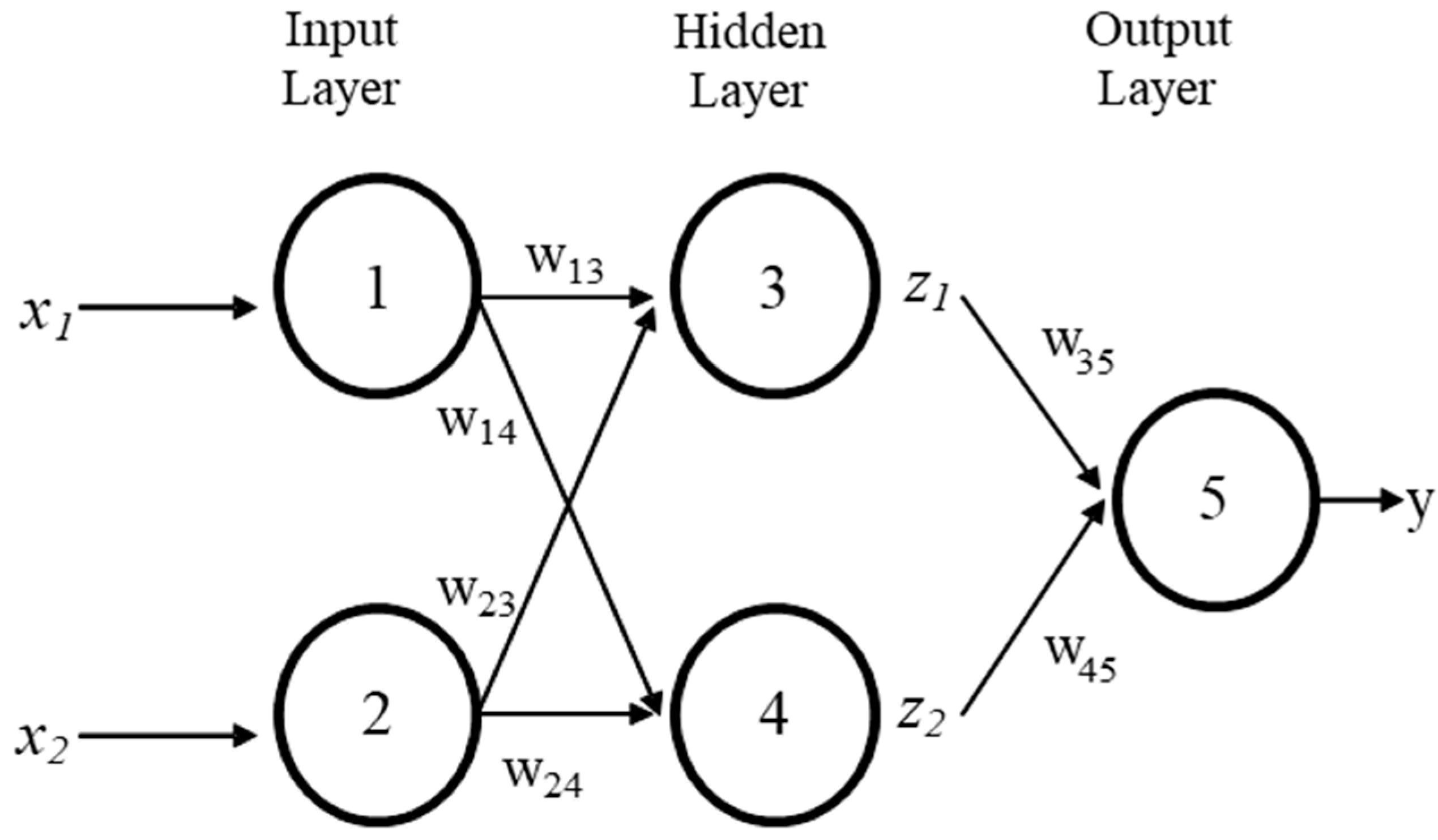
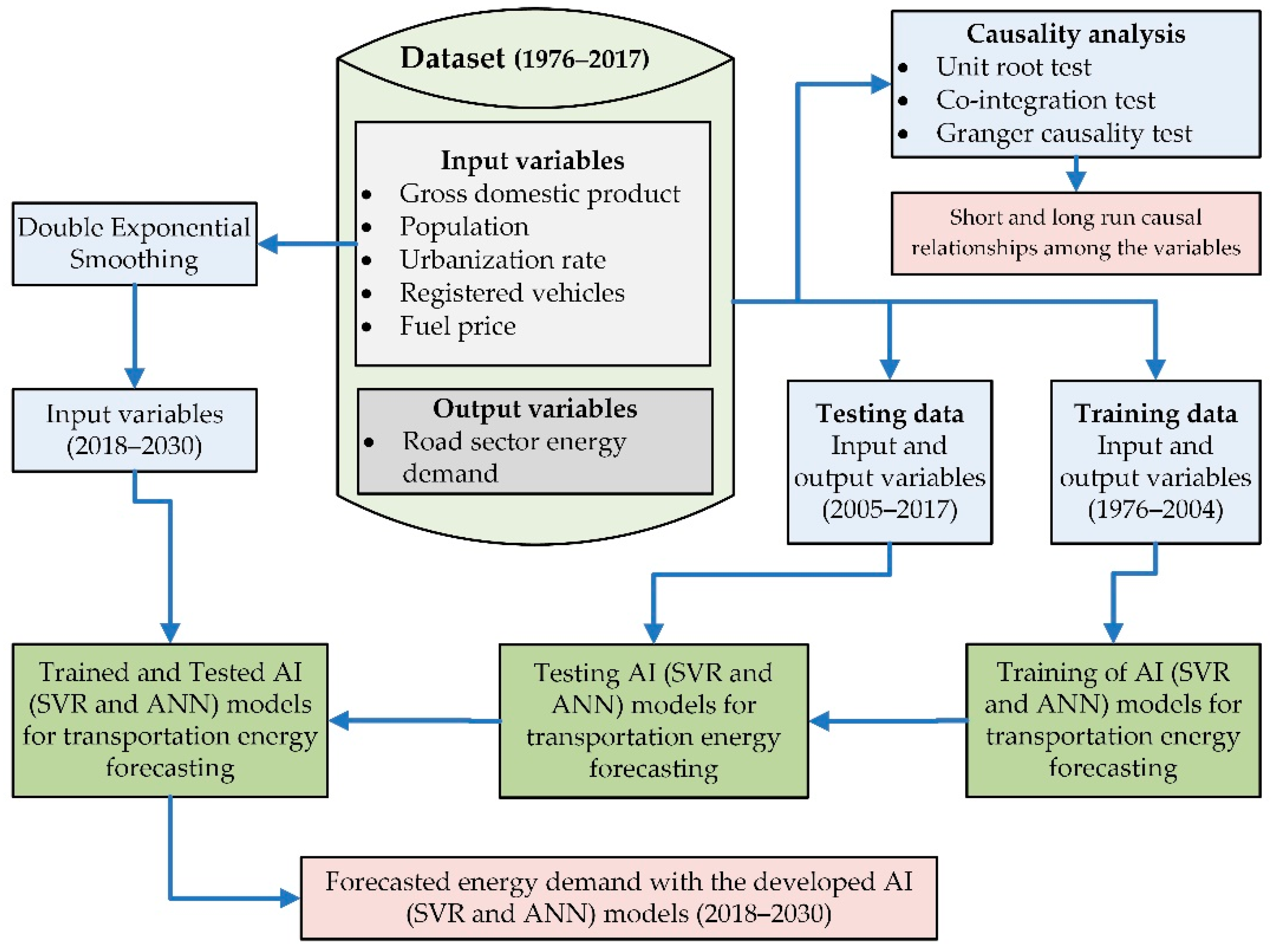
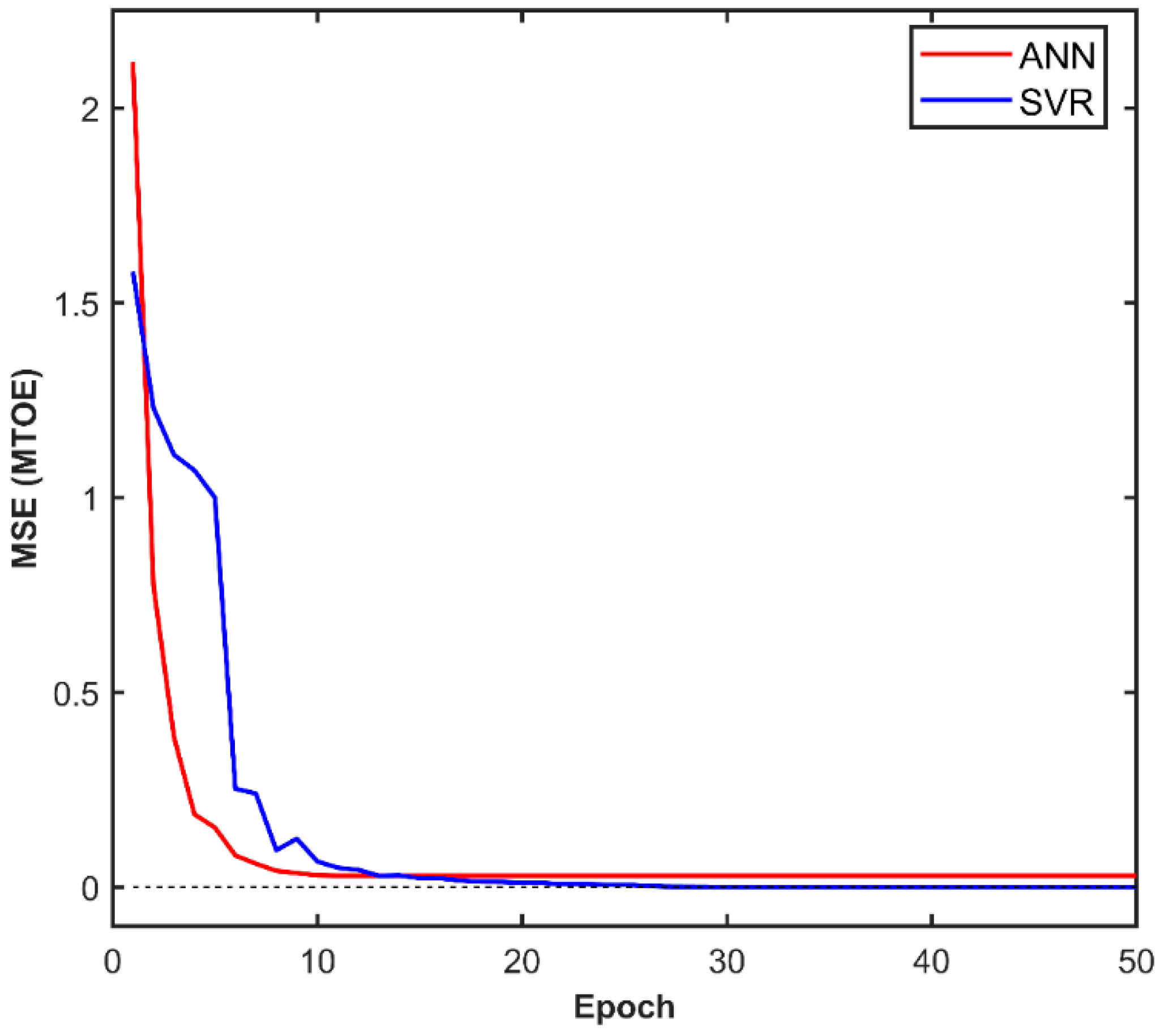

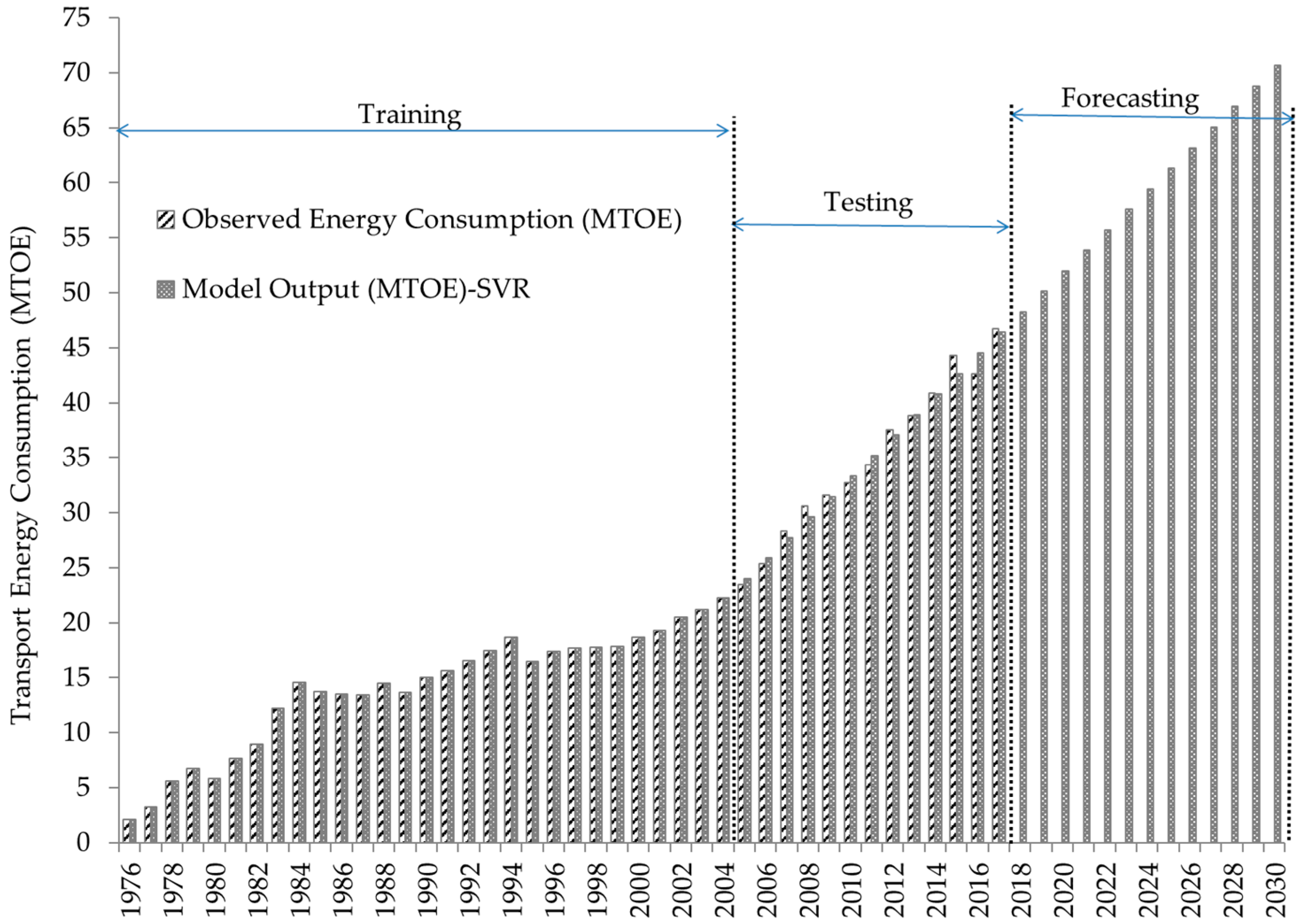
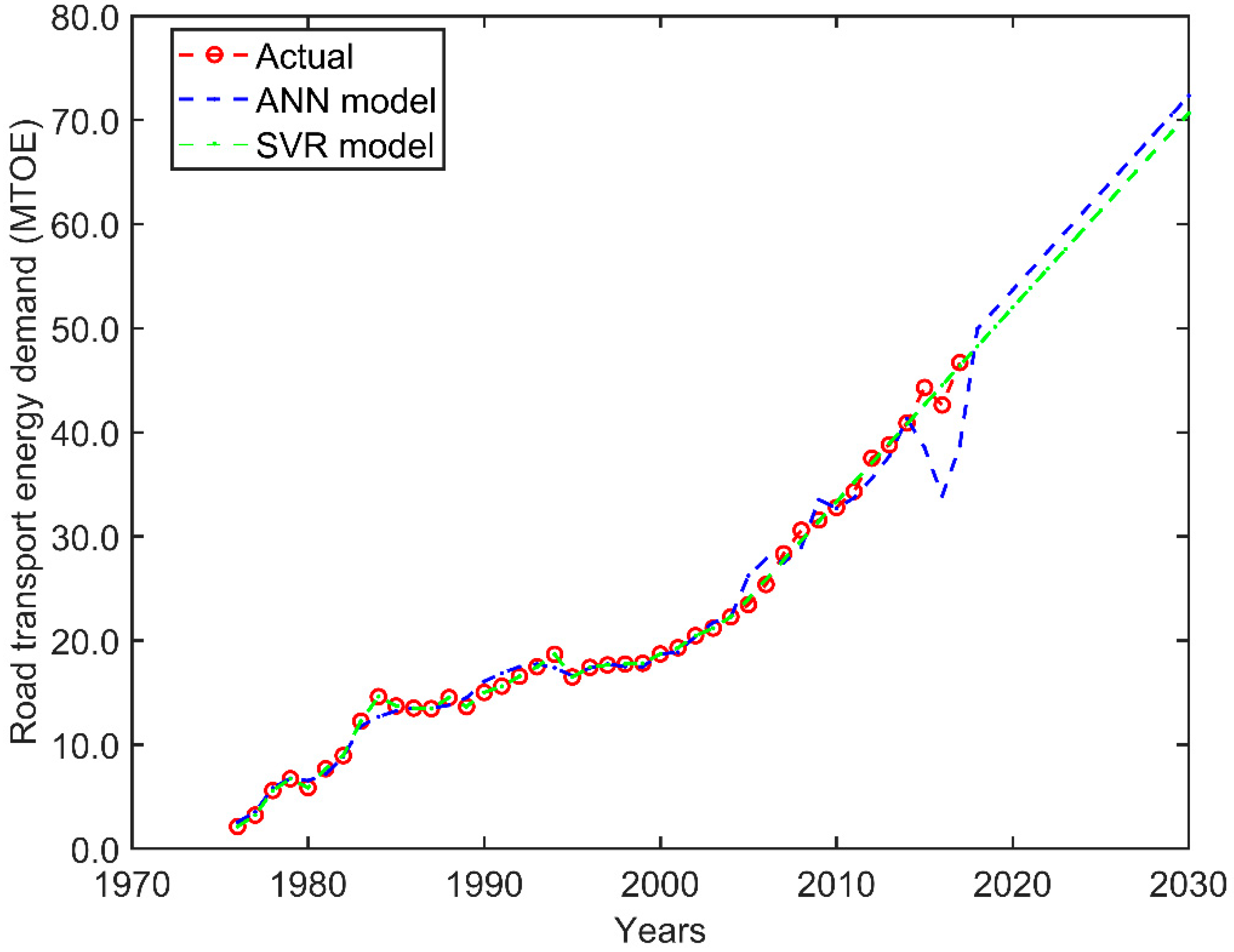
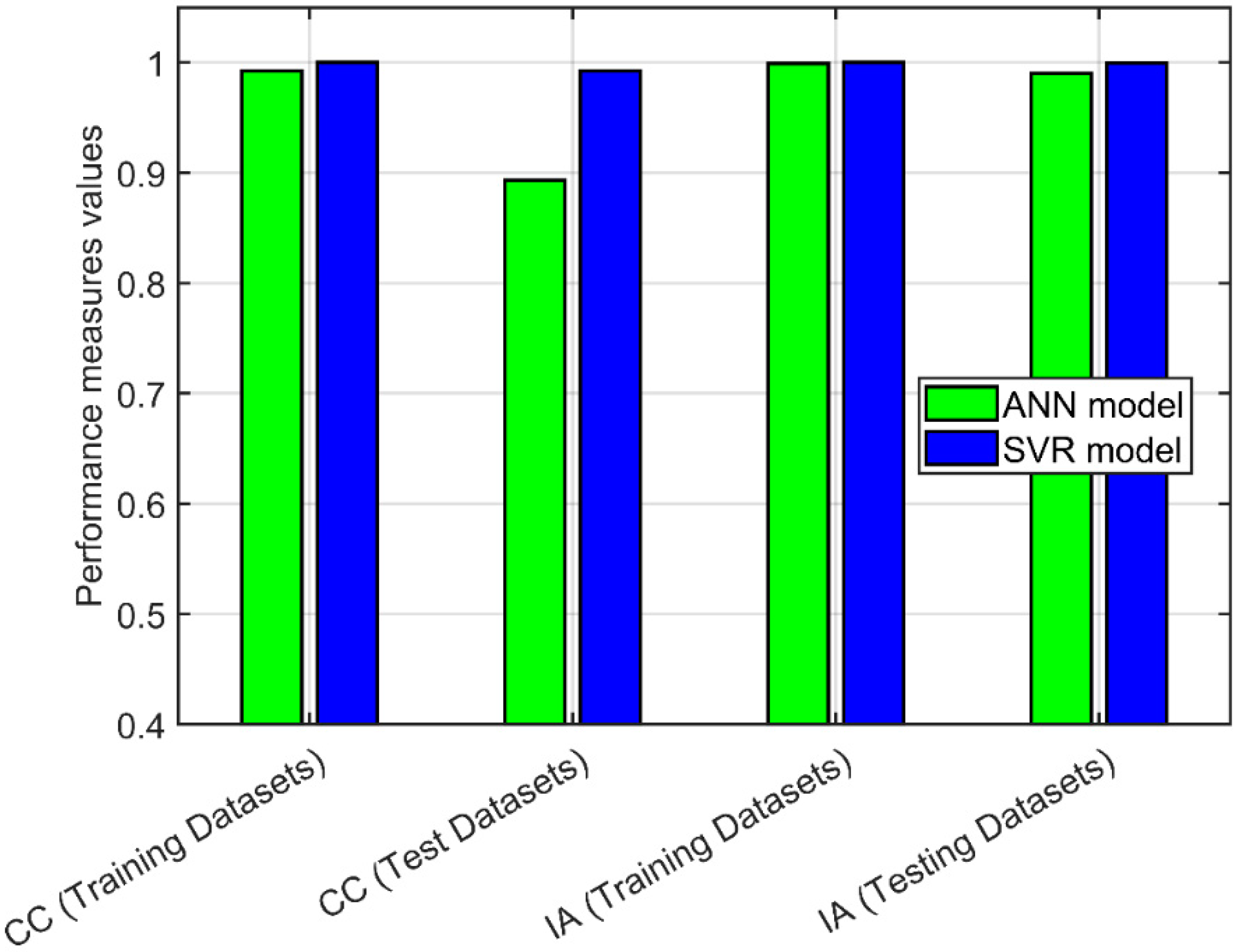
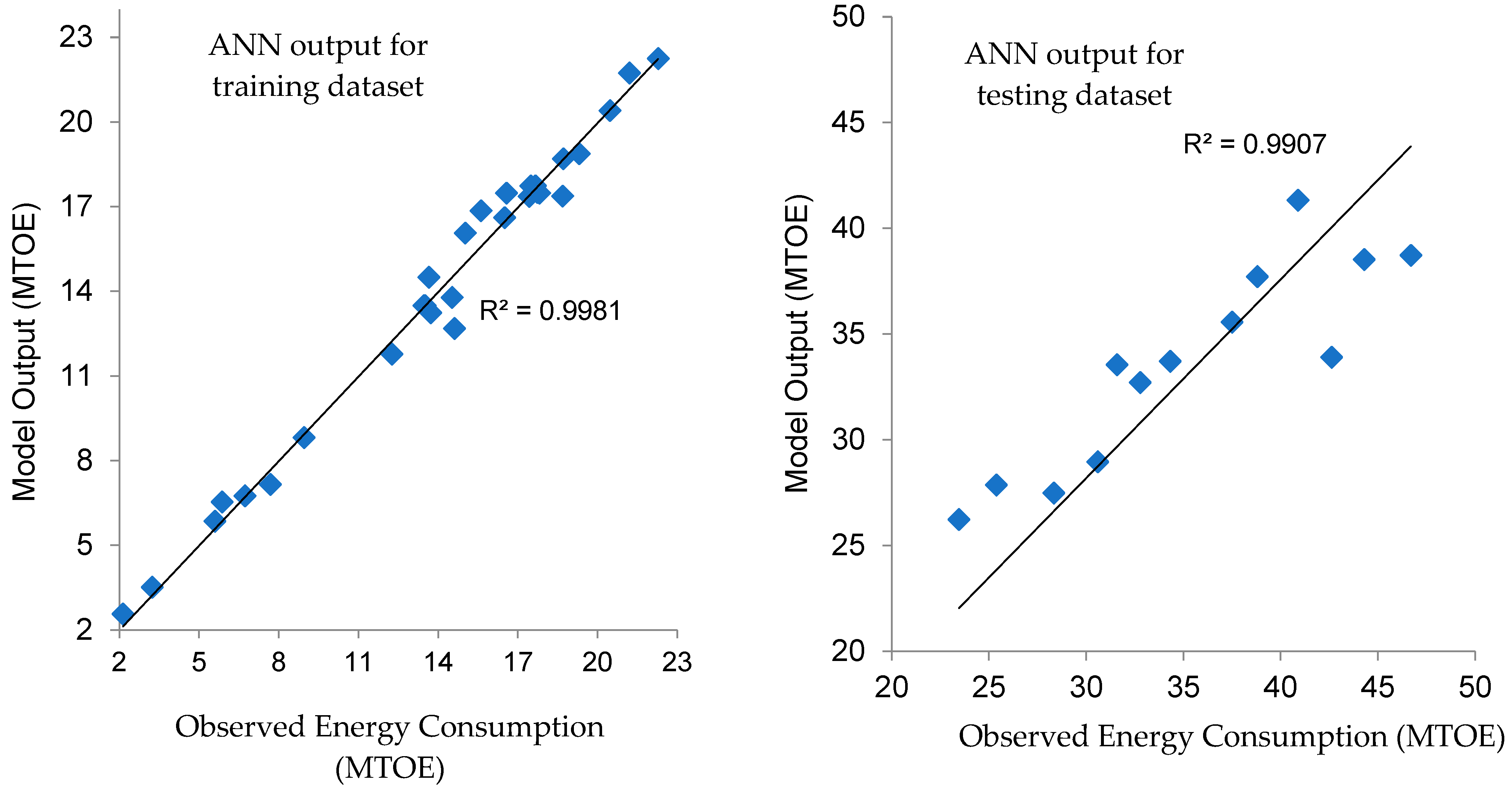

| At Level | ADF (Lag Length) | PP (Lag Length) | ||
|---|---|---|---|---|
| Intercept | Intercept and Trend | Intercept | Intercept and Trend | |
| E | 2.03 (1) | −2.23 (0) | 2.42 (3) | −2.54 (6) |
| GDP | −0.50 (0) | −1.92 (0) | −0.50 (0) | −2.06 (1) |
| P | −1.18 (0) | −1.04 (0) | −1.43 (1) | −1.31 (1) |
| U | 4.14 (3) | −3.66 ** (4) | 4.65 (2) | −3.95 ** (2) |
| V | 1.36 (1) | −0.68 * (1) | 7.09 (2) | −1.18 (2) |
| At first difference | Intercept | Intercept and Trend | Intercept | Intercept and Trend |
| E | −4.81 (0) *** | −6.19 (0) *** | −4.82 (2) *** | −6.20 (1) *** |
| GDP | −3.82 (2) *** | −3.75 (0) ** | −3.84 (2) *** | −3.73 (2) ** |
| P | −3.43 (0) ** | −3.39 (0) * | −3.43 (0) ** | −3.39 (0) * |
| U | −2.50 * (4) | 2.34 (3) | −2.07 * (2) | 0.30 (2) |
| V | −039 (0) * | −2.00 (0) | −0.39 (0) | −2.00 (0) |
| Hypothesized Number of Co-Integrating Equation(s) | r = 0 | r = 1 | r = 2 | r = 3 | r = 4 |
|---|---|---|---|---|---|
| Trace statistics | 113.91 *** | 61.58 *** | 27.04 | 7.21 | 0.57 |
| Maximum Eigenvalue statistics | 52.33 *** | 34.54 *** | 19.83 | 6.64 | 0.57 |
| Dependent Variable: TE | |||
|---|---|---|---|
| Explanatory Variables | Coefficients | Standard Error | t-Statistics |
| Constant | 11.8 | 13.71 | 0.86 |
| GDP | 0.003 | 0.017 | 0.176 |
| P | −127.10 | 35.91 | −3.54 |
| U | −17.73 | 2.53 | −7.00 |
| V | 14.35 | 1.82 | 19.23 |
| Short-Run Granger Causality—F Statistics | Long-Run Granger Causality—t-Statistics | |||||
|---|---|---|---|---|---|---|
| Ln (E) | Ln (GDP) | Ln (P) | Ln (U) | Ln (V) | Error Correction Term (ECT) | |
| Ln (E) | - | 3.93 * (0.07) | 0.04 (0.85) | 3.63 * (0.08) | 0.20 (0.66) | −1.58 (0.14) |
| Ln (GDP) | 1.52 (0.24) | - | 8.02 ** (0.02) | 5.21 ** (0.04) | 4.53 * (0.05) | 1.98 * (0.07) |
| Ln (P) | 3.11 (0.10) | 0.01 (0.92) | - | 0.01 (0.91) | 0.03 (0.86) | 0.45 (0.66) |
| Ln (U) | 0.60 (0.45) | 0.29 (0.60) | 0.79 (0.39) | - | 3.31 * (0.09) | 1.91 * (0.08) |
| Ln (V) | 0.003 (0.96) | 2.17 (0.17) | 0.19 (0.67) | 3.02 (0.10) | - | 0.19 (0.85) |
| Heading | RMSE (MTOE) | MAE (MTOE) | MAPE | CC | IA |
|---|---|---|---|---|---|
| Training Datasets (ANN) | 0.7 | 0.43 | 4.34 | 0.9924 | 0.9989 |
| Testing Datasets (ANN) | 3.9 | 15.39 | 7.53 | 0.8932 | 0.9899 |
| Training Datasets (SVR) | 0.0 | 0.00 | 0.00 | 1 | 1 |
| Testing Datasets (SVR) | 0.9 | 0.73 | 1.91 | 0.9925 | 0.9996 |
Publisher’s Note: MDPI stays neutral with regard to jurisdictional claims in published maps and institutional affiliations. |
© 2022 by the authors. Licensee MDPI, Basel, Switzerland. This article is an open access article distributed under the terms and conditions of the Creative Commons Attribution (CC BY) license (https://creativecommons.org/licenses/by/4.0/).
Share and Cite
Rahman, M.M.; Rahman, S.M.; Shafiullah, M.; Hasan, M.A.; Gazder, U.; Al Mamun, A.; Mansoor, U.; Kashifi, M.T.; Reshi, O.; Arifuzzaman, M.; et al. Energy Demand of the Road Transport Sector of Saudi Arabia—Application of a Causality-Based Machine Learning Model to Ensure Sustainable Environment. Sustainability 2022, 14, 16064. https://doi.org/10.3390/su142316064
Rahman MM, Rahman SM, Shafiullah M, Hasan MA, Gazder U, Al Mamun A, Mansoor U, Kashifi MT, Reshi O, Arifuzzaman M, et al. Energy Demand of the Road Transport Sector of Saudi Arabia—Application of a Causality-Based Machine Learning Model to Ensure Sustainable Environment. Sustainability. 2022; 14(23):16064. https://doi.org/10.3390/su142316064
Chicago/Turabian StyleRahman, Muhammad Muhitur, Syed Masiur Rahman, Md Shafiullah, Md Arif Hasan, Uneb Gazder, Abdullah Al Mamun, Umer Mansoor, Mohammad Tamim Kashifi, Omer Reshi, Md Arifuzzaman, and et al. 2022. "Energy Demand of the Road Transport Sector of Saudi Arabia—Application of a Causality-Based Machine Learning Model to Ensure Sustainable Environment" Sustainability 14, no. 23: 16064. https://doi.org/10.3390/su142316064
APA StyleRahman, M. M., Rahman, S. M., Shafiullah, M., Hasan, M. A., Gazder, U., Al Mamun, A., Mansoor, U., Kashifi, M. T., Reshi, O., Arifuzzaman, M., Islam, M. K., & Al-Ismail, F. S. (2022). Energy Demand of the Road Transport Sector of Saudi Arabia—Application of a Causality-Based Machine Learning Model to Ensure Sustainable Environment. Sustainability, 14(23), 16064. https://doi.org/10.3390/su142316064












